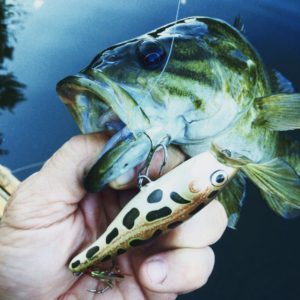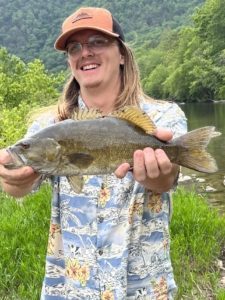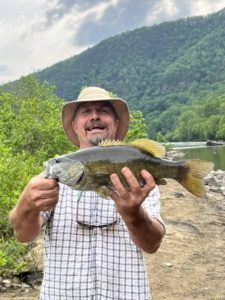Rugged Land, an Ancient River and Smallmouth Bass: The French Broad River in Madison County, North Carolina
Rugged Land, an Ancient River and Smallmouth Bass:
The French Broad River in Madison County, North Carolina
 By Pete Dixon at Broadwing Farm Cabins
By Pete Dixon at Broadwing Farm Cabins
pete@broadwingfarmcabins.com
If you know Madison County NC, you know a place of beauty and unique character. I’ve been trying to get to know Madison County for more than 30 years, and I believe that I have only scratched the surface. The first thing to know is this: it is a rugged land shaped by an ancient river, and people shaped by that land. It’s rich in life and history. It is diverse and beautiful beyond comparison. So much has been said of the scenery and history of Madison County, yet one critical point is often missed in those tales. The overlooked point is fishing. There is excellent fishing here and it is one of the most scenic watersheds in Eastern North America. There are over 80 species of fish documented in the French Broad. I myself have caught at least 10 species of gamefish, within just a couple miles around Hot Springs – largemouth, spotted bass, rock bass, white bass, musky, walleye, sauger, catfish, drum and bluegill. The list goes on and on, but the stand out in the French Broad is the smallmouth bass. Smallmouth fishing can be exciting in the extreme, the kind that can leave your adrenaline gland in the gutter, and if you’re not prepared, you may end up wishing you had stronger hooks.
The Habitat– The French Broad is mostly rock and sand, with lots of rapids, ledges, cliffs, and pools. There are eddies ranging in size from a bathroom sink to a couple of acres. The valley through Madison County is mountainous with forested slopes and rocky bluffs around every bend. In Madison County, there are put-ins at Redman Damn, Barnard, Stackhouse, Hot Springs, Murray Branch, and informally Paint Rock. To fish Section 9, which stretches from Marshall to Hot Springs, you should start with a guide or fish from the bank, unless you are an experienced whitewater paddler. It’s class 2 whitewater though section 9, with some class 3 moments and it’s very remote so if you get in a pickle, help is not right around the corner. With all this moving water, the pools and eddies make excellent smallmouth habitat.
Section 10 starts in Hot Springs and goes to the Tennessee border. The rapids are more mellow and novices commonly navigate this section. There is also excellent shore fishing upstream and downstream from Hot Springs.
Break it down by seasons.
Summer> Post spawn, fish can be plentiful. Food is abundant and the temperatures support active feeding. Look for fish close to, or in current. Micro eddies will consistently hold fish. Bigger fish will often be in bigger eddys, but close to the current. For bait, soft plastics are king, but try anything. I use ¼ oz jig heads with my plastic, because this river is big and strong. Avoid jig heads with thin wire hooks! Switch colors often, looking for the bite if you aren’t getting consistent action. Small crank baits can work well in small eddies. Surface action can be great any time, but most often it picks up in the evenings, in shadows and around limbs and overhangs. Most fish will be close to moving water, especially in the day, but they typically spread out in the evenings to some calmer areas. The trick in the summer is to remember there are feeding fish all around you. Switch it up frequently until you find that bite. When the water temps get very warm, oxygen is limiting, so you are looking for fish in proximity to churning white oxygenated water, they will be right up on some bubbles. Summer fish are on average smaller, and some days the size may average out to only 12”. But those same days you may see 30, even 50 fish and that’s a lot of fun. And bigger fish will be encountered occasionally feeding along with the smaller fish. Sometimes evening attention to shadows and larger eddies with surface lures can temp out the big ones.
Fall> When the water starts to cool off, the fish will move out of the current, away from bubbles and micro eddies, into medium sized eddies and pools, behind ledges and behind rocks. Many of the summer holes still hold fish, but they will have loosened their attention on fast moving, bubbly water. Soft plastics are still excellent, but now presented slower and lower in deeper pools. Slow presentation of crawdad patterns is one of my go-to’s in the fall. Bigger crank baits cast across wide stretches of deep water can turn up some big solo fish in surprise action. Fall fish run the gamut in size, but include more +15” fish. Hinged Rapalas and other minnow patterns can be hot in the fall.
Winter> Winter fishing is my favorite and possibly the best kept secret of the French Broad. I am skunked more in the winter, but it’s worth it because when you find the fish, buckle in. Winter fish are big, strong and cooler temperatures don’t dampen their will. Now the fish have congregated around the edges of big pools, still close to the current, but big eddies and slower currents are involved. Look for schools on the tail end of a pool and over upstream facing drop offs and ledges. They surf the big underwater waves around interesting structures. If you get a fish, stop moving and start fishing right there, because they stick together in the winter. A good winter spot can be a very particular and compact spot, and that little spot can pay off again and again for years. Crawdad colored grubs retrieved low and slow, and big deep diving crawdad colored crank baits pay off during the winter months. Strikes in the winter can be subtle compared to spring in summer fish. While spring fish often attack with a devilish TAP!, or more frequently TAP! TAP!, the winter hit can be subtle, even a suspicious slacking of the line. If you’re not sure, set the hook anyway! Start watching the USGS temperature gauge online. The afternoon temperature peak during the last 2 days of a warming trend can be awesome. Fish can average 17” this time of year, and it’s your best shot at a rare +20”. Get your forearms in shape, and don’t skimp on hooks, unless you like to see them straightened.
Spring> When daytime water temps start to average in the 60s the fish will fan out from the big pools to faster, smaller eddies and towards spawning areas. Jerk baits, and minnow patterned plastics and swimbaits can be great. Shallow pools and small edge eddys will again be productive. Accurate casting to edge pockets with jerks and grubs is called for. The big ones will be hungry pre spawn, so be ready for a good number of +15” fish.
 Gear– The French Broad is big and pushy. When you hook a plus 17” fish out across a hundred feet of current your pole is going to earn its’ keep. And with a lot of “Broad” water, long casts can boost your odds. My favorite rig is a fast or medium-fast 7’ graphite pole loaded with 8 pound monofilament. And I tend towards big heavy lures to cover more water with long casts. I never go out without a large selection of soft plastics and crank baits. Next down the list is stick baits, hinged Rapalas and spinner baits. The best color can be hard to predict, but it makes all the difference so come prepared with a variety. Crawdad patterns are always a favorite.
Gear– The French Broad is big and pushy. When you hook a plus 17” fish out across a hundred feet of current your pole is going to earn its’ keep. And with a lot of “Broad” water, long casts can boost your odds. My favorite rig is a fast or medium-fast 7’ graphite pole loaded with 8 pound monofilament. And I tend towards big heavy lures to cover more water with long casts. I never go out without a large selection of soft plastics and crank baits. Next down the list is stick baits, hinged Rapalas and spinner baits. The best color can be hard to predict, but it makes all the difference so come prepared with a variety. Crawdad patterns are always a favorite.
It’s a wild and wooly river so unless you’re an experienced boater, you would be prudent to come with a guide. Matt Cook at the Laurel River Store is a local legend. If you can catch him for a trip, you’ll be off to a good start. And stop by High Ridge Adventures Outfitters on your way into the county for top notch barbecue, gear, fishing conditions and tips.

